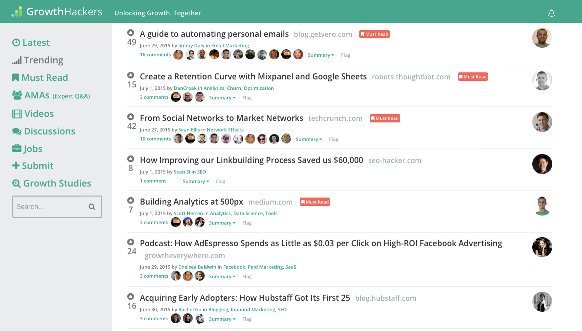Growth Hacking: How to Choose the Right Approach for Your Company
There are two completely different types of grower hacking. One for startups, the other for growth companies. It is important to be able to choose the right strategy. If you make a mistake, then there is a very high probability of screwing up in the future.

If you are not familiar with the concept of Growth Hacking, and want to pump in this thread, be sure to read our first article - Do you know what Growth Hacking is? [11 cases inside] . From it you will learn what it is, where it is applied, and with real examples you can feel the power of growling hacking. So do not forget to join the closed online community GrowthHackingIdea.com (It already has more than 25,000 people). You can get there only by invitation , there are no other ways.
So, we will consider two approaches in grows hacking on the basis of two important people in this area - Andy Jones and Sean Ellis. Some consider them the most influential grower hackers. To some extent, they are the founders of this topic. But!
They are completely different people. And their approaches to grows hacking are completely opposite. Let's see how and why they are so different.
Andy Jones is a former employee of the largest companies on the Internet - Twitter and Facebook. He currently leads the Wealthfront e-investment platform development department. Andy grew up on a farm near California. He is calm, unhurried, disciplined, with web analytics on “you”.
Sean Ellis is a former marketing manager at Dropbox (a company that was able to grow multiple times thanks to cool groovy hacks), Lookout and LogMeIn, the creator of Qualaroo (a survey service) and the online community GrowthHackers.com. By the way, it was Sean who coined the term “Growth Hacking” in 2010.

Sean uses completely different strategies in growl hacking. He is the exact opposite of his colleague. He began his career in direct sales long before online advertising became the main engine of development. Sean is persistent, tenacious, “hungry” to new customer sources and technologies. He is constantly in search of something new: he finds - checks - analyzes - draws conclusions. And this cycle goes on continuously.
Perhaps that is why he and his colleagues managed to bring the value of Uproar (one of the largest companies in the advertising market) to $ 1 billion. And then sell it to Vivendi Universal. Personally, I have no doubt that the constant desire for experimentation, for everything new was one of the factors of this success.

The difference in approaches is related to the fact that Andy Jones does and does this in large and stable companies, and Sean Ellis used grow hacking to turn small startups into multi-million dollar and even billion-dollar projects. It is from here that the roots grow.
While working on Twitter, Andy makes small changes that step by step, by several percent, increase the conversion, engagement and retention of users. This is something like horizontal growth when a company develops by improving what it already has.
Related Article - How to Increase Conversion - 30 Short Tips for Internet Marketers
Sean is engaged in vertical growth. He is looking for new opportunities to attract and activate customers who can give a multiple growth of the company, and not increase the registration by a couple of percent.
In the original of this article, the author called the growers of hackers two terms of the gold rush. Sean Ellis is a "scout," and Andy Jones is a "prospector." The Scout represents the startup phase, the prospector represents the growth phase.
“Scouts” are needed at a time when the company is in search of its place in the sun, has not yet received investment, has not found and has not optimized the sources of attracting and activating users.
"Prospectors" are needed at a time when the company is doing well - the process of attracting users has been worked out, the activation process has been established. In such a situation, grower hacker skills are needed to analyze current data, generate and test hypotheses, and improve interaction with users. And this, in the end, leads to a gradual further growth of the company.
I think that now you understand the difference between two completely opposite approaches to grow hacking.
Despite the fact that these two approaches are so different from each other, the “scouts” and “prospectors” have common features. Traits that Growth Hacking is impossible without.

This is a fundamental feature of grower hacking. And not only him. Any marketing activity is good if it can be measured and based on this draw conclusions about effectiveness.
Using the data, “scouts” evaluate the effectiveness of their actions, and “prospectors” find problem areas in the project. As a rule, a “scout” has less data at the time of the realization of his ideas (often qualitative data obtained through surveys and communication with the target audience are used). But much more information appears after the implementation of hacks. And these data allow us to accurately assess the effect obtained.
Related article - Overview of services for conducting user polls
Agree that if we can measure any of our activity, then we can objectively evaluate it. And after you make a decision - is there any sense and potential effect for the business from this action or not.
By the way, this also allows you to get rid of situations when someone who is higher in office imposes his personal opinion. It can be very difficult to prove the opposite, especially to your boss or colleague. With accurate statistics, you can always put such a person in place and avoid mistakes.
In general, data analysis and hypothesis generation based on the analyzed information is a must-have not only for a grower hacker, but also for any modern Internet marketer. This allows you to do the so-called Data Driven Marketing, when all decisions are made on the basis of numbers, and not subjective opinions.
Related article - They will help you find all the "killers" of the conversion - 10 reports in Google Analytics
Implementing grow hacks both at the start-up stage and at the growth stage is almost impossible without technical skills. Of course, in most cases, developers are helping growers (especially in large companies), but minimal knowledge is still needed.

Growth hacker needs to understand how everything is implemented from a technical point of view and whether it is possible to do what he has in his head. Minimum technical skills also allow you to easily communicate with developers and draw up a technical task.
Marketers and developers speak different languages. It is obvious. And sometimes some do not understand others. And how then can a grower hacker be able to explain what he needs from the developer? On fingers? No, friends, Growth Hacking in both approaches requires technical knowledge.
In addition, it is sometimes much easier to do something yourself than to involve employees from other departments. This is a time saver that allows you to test hypotheses faster, collect data and draw conclusions.
By the way, neither Sean Ellis nor Andy Jones are engineers by education and have never studied at universities. In the process of work, they just had to deal with technical issues every time and gradually get pumped into it. And yes, this is normal for a grower hacker. He has to figure out many things.
Whatever the approach to grow hacking, at the heart of everything is the client, the user. It is he and no one else. Therefore, any grower hacker cares first and foremost about the client.
At the startup stage, “scouts” communicate with all their customers. This allows you to understand what problems the target audience has, what they lack and what they need from your project. And based on this, the grower hacker “scout” builds a further project strategy that will meet the expectations and needs of customers.
At the growth stage, "prospectors" also focus on customers - they collect and analyze all possible data about users, build hypotheses on the basis of this, and make decisions about their actions.
Sean Ellis spoke very well about customer focus: "The developers are focused on writing code, so they have too few ideas about real problems and expectations of potential customers." Therefore, any grower hacker, regardless of approach, should put the client and his needs in the first place.
Topic Article - Know Your Target Audience or Die: 34 Vital Issues
Of course, there are growl hackers individualists. It is possible that at one time Sean was just that. But teamwork is much more effective. Not a single grower hacker will find the time and energy to come up with, implement and analyze all ideas.

As a rule, a team has developers, designers, copywriters and other specialists. To implement ideas as quickly as possible, you need to learn teamwork. You need to be able to listen to others, adequately evaluate criticism and objectively look at both your ideas and the ideas of colleagues.
For example, take a brainstorm. The grower hacker individualist can alone sit and soar over ideas. Or it will be 5-10 people with different competencies, skills and attitudes. Most likely, the second option will be much more effective. That is why grows hacking requires a well-coordinated team that moves towards one goal - business growth.
A cool grower hacker is a curious person, hungry for everything new, untested and non-standard. It is curiosity and craving for new knowledge that allows you to constantly pump your skills.
Growth hacker does not stand still. He follows all the trends in the industry. He analyzes the cases of others. He does not agree with unconfirmed hypotheses. If he is told that a certain technique does not work, then he does not believe the word. Either there is confirmation, the data collected and analyzed, or it needs to be tested.
Grose the hacker is not afraid to learn new disciplines. If he needs to be able to write code in his work, then he plunges into this sphere. If you need to learn how to analyze data in depth, then he does it. If you need to learn a new marketing service, then he is always ready for it.
Oh, by the way, the grower hacker is never afraid to try a new, non-standard one. After all, it is behind non-standard techniques that sometimes incredible growth is hidden. Remember how Paypal launched a referral program in 2001 , in which both the invitee and the invitee were given 10 bucks. Real bucks. It seems that this is an incredible solution that cost the company a lot of money.
Yes, it was a non-standard technique for that time. Perhaps Paypal was the first company on the Internet to successfully use this hack. And he paid off in the long run (attracting users through a referral program was much cheaper than through other sources).
A cool grower hacker must be consistent in his actions. Random actions will lead to nothing. That is why you need to be able to systematically approach your work.
Most grower hackers use various systems to organize work. The HADI loop system is a good example. In one form or another (with certain changes, additions) it is used by many. HADI stands for Hypothesis> Action> Data> Insight.
At the first stage, the grower hacker generates hypotheses (which are prioritized according to the degree of potential impact on the business, ease of implementation and importance - the PIE method). In the second stage, he tests the hypothesis. On the third - analyzes the test results. In the fourth, he concludes and proceeds to test the next hypothesis.
Topic Article -Case Carrot Quest: What are HADI loops and how to accelerate the development of a project Using them
By the way, prioritization is a very important feature of a grower hacker. There can be countless ideas for improving a product. But it will never be possible to test all ideas - we are limited in time and means. Therefore, among all the ideas that come to the head of the team, you need to choose those that have the greatest potential for business.

This is really important. Many people make a mistake when they start to do something that does not affect the main goal of the business. Therefore, you need to be able to separate the grain from the chaff. Although it can be difficult at times, it’s nowhere without it.
Growth hacking will not improve your business in one day or even a month. Growth hacking is a long-term, consistent and patient work aimed at long-term growth.
A competent grower hacker should be patient and not give up on the first failure. The reality is that most hypotheses will not bring you anything. You will test, and see the same result, if not worse. But there are 5-10-20% of hypotheses that will shoot and ensure powerful growth of the company.
Therefore, it is important to have an endurance and consistently go to the goal.
In the next article I will talk about 10 interesting grow hacks, which allowed to multiply increase the growth of various companies.
By the way, if you forgot to join the closed GrowthHackingIdea community , here is your personal invitation. Click on it, after which you will be able to access the daily growers.
Original article - http://venturebeat.com/2015/08/11/growth-hacking-has-two-phases-and-using-the-wrong-one-can-sink-you/
If you want your friends and colleagues learned more about Growth Hacking, share this article on social networks. They will be grateful for that. And I am even more so!
Prepared by the Boosta.ru blog and the Changeagain.me project. Also
read our other popular articles:
1. They will help you find all the "killers" of the conversion - 10 reports in Google Analytics (5000+ views)
2. The biggest mistake in A / B testing (2 000+ views)
3.100 ideas for A / B testing. Part One (2000+ views)
4. 100 ideas for A / B testing: Part Two (1000+ views)
5. How to find an idea for A / B test: heatmaps and polls (1000+ views)

If you are not familiar with the concept of Growth Hacking, and want to pump in this thread, be sure to read our first article - Do you know what Growth Hacking is? [11 cases inside] . From it you will learn what it is, where it is applied, and with real examples you can feel the power of growling hacking. So do not forget to join the closed online community GrowthHackingIdea.com (It already has more than 25,000 people). You can get there only by invitation , there are no other ways.
Startup and Growth Growth Hacking
So, we will consider two approaches in grows hacking on the basis of two important people in this area - Andy Jones and Sean Ellis. Some consider them the most influential grower hackers. To some extent, they are the founders of this topic. But!
They are completely different people. And their approaches to grows hacking are completely opposite. Let's see how and why they are so different.
Andy Jones is a former employee of the largest companies on the Internet - Twitter and Facebook. He currently leads the Wealthfront e-investment platform development department. Andy grew up on a farm near California. He is calm, unhurried, disciplined, with web analytics on “you”.
Sean Ellis is a former marketing manager at Dropbox (a company that was able to grow multiple times thanks to cool groovy hacks), Lookout and LogMeIn, the creator of Qualaroo (a survey service) and the online community GrowthHackers.com. By the way, it was Sean who coined the term “Growth Hacking” in 2010.

Sean uses completely different strategies in growl hacking. He is the exact opposite of his colleague. He began his career in direct sales long before online advertising became the main engine of development. Sean is persistent, tenacious, “hungry” to new customer sources and technologies. He is constantly in search of something new: he finds - checks - analyzes - draws conclusions. And this cycle goes on continuously.
Perhaps that is why he and his colleagues managed to bring the value of Uproar (one of the largest companies in the advertising market) to $ 1 billion. And then sell it to Vivendi Universal. Personally, I have no doubt that the constant desire for experimentation, for everything new was one of the factors of this success.

The difference in approaches is related to the fact that Andy Jones does and does this in large and stable companies, and Sean Ellis used grow hacking to turn small startups into multi-million dollar and even billion-dollar projects. It is from here that the roots grow.
While working on Twitter, Andy makes small changes that step by step, by several percent, increase the conversion, engagement and retention of users. This is something like horizontal growth when a company develops by improving what it already has.
Related Article - How to Increase Conversion - 30 Short Tips for Internet Marketers
Sean is engaged in vertical growth. He is looking for new opportunities to attract and activate customers who can give a multiple growth of the company, and not increase the registration by a couple of percent.
In the original of this article, the author called the growers of hackers two terms of the gold rush. Sean Ellis is a "scout," and Andy Jones is a "prospector." The Scout represents the startup phase, the prospector represents the growth phase.
“Scouts” are needed at a time when the company is in search of its place in the sun, has not yet received investment, has not found and has not optimized the sources of attracting and activating users.
"Prospectors" are needed at a time when the company is doing well - the process of attracting users has been worked out, the activation process has been established. In such a situation, grower hacker skills are needed to analyze current data, generate and test hypotheses, and improve interaction with users. And this, in the end, leads to a gradual further growth of the company.
I think that now you understand the difference between two completely opposite approaches to grow hacking.
Despite the fact that these two approaches are so different from each other, the “scouts” and “prospectors” have common features. Traits that Growth Hacking is impossible without.
All decisions are based on data.

This is a fundamental feature of grower hacking. And not only him. Any marketing activity is good if it can be measured and based on this draw conclusions about effectiveness.
Using the data, “scouts” evaluate the effectiveness of their actions, and “prospectors” find problem areas in the project. As a rule, a “scout” has less data at the time of the realization of his ideas (often qualitative data obtained through surveys and communication with the target audience are used). But much more information appears after the implementation of hacks. And these data allow us to accurately assess the effect obtained.
Related article - Overview of services for conducting user polls
Agree that if we can measure any of our activity, then we can objectively evaluate it. And after you make a decision - is there any sense and potential effect for the business from this action or not.
By the way, this also allows you to get rid of situations when someone who is higher in office imposes his personal opinion. It can be very difficult to prove the opposite, especially to your boss or colleague. With accurate statistics, you can always put such a person in place and avoid mistakes.
In general, data analysis and hypothesis generation based on the analyzed information is a must-have not only for a grower hacker, but also for any modern Internet marketer. This allows you to do the so-called Data Driven Marketing, when all decisions are made on the basis of numbers, and not subjective opinions.
Related article - They will help you find all the "killers" of the conversion - 10 reports in Google Analytics
Minimum technical skills
Implementing grow hacks both at the start-up stage and at the growth stage is almost impossible without technical skills. Of course, in most cases, developers are helping growers (especially in large companies), but minimal knowledge is still needed.

Growth hacker needs to understand how everything is implemented from a technical point of view and whether it is possible to do what he has in his head. Minimum technical skills also allow you to easily communicate with developers and draw up a technical task.
Marketers and developers speak different languages. It is obvious. And sometimes some do not understand others. And how then can a grower hacker be able to explain what he needs from the developer? On fingers? No, friends, Growth Hacking in both approaches requires technical knowledge.
In addition, it is sometimes much easier to do something yourself than to involve employees from other departments. This is a time saver that allows you to test hypotheses faster, collect data and draw conclusions.
By the way, neither Sean Ellis nor Andy Jones are engineers by education and have never studied at universities. In the process of work, they just had to deal with technical issues every time and gradually get pumped into it. And yes, this is normal for a grower hacker. He has to figure out many things.
Customer focus
Whatever the approach to grow hacking, at the heart of everything is the client, the user. It is he and no one else. Therefore, any grower hacker cares first and foremost about the client.
At the startup stage, “scouts” communicate with all their customers. This allows you to understand what problems the target audience has, what they lack and what they need from your project. And based on this, the grower hacker “scout” builds a further project strategy that will meet the expectations and needs of customers.
At the growth stage, "prospectors" also focus on customers - they collect and analyze all possible data about users, build hypotheses on the basis of this, and make decisions about their actions.
Sean Ellis spoke very well about customer focus: "The developers are focused on writing code, so they have too few ideas about real problems and expectations of potential customers." Therefore, any grower hacker, regardless of approach, should put the client and his needs in the first place.
Topic Article - Know Your Target Audience or Die: 34 Vital Issues
Teamwork
Of course, there are growl hackers individualists. It is possible that at one time Sean was just that. But teamwork is much more effective. Not a single grower hacker will find the time and energy to come up with, implement and analyze all ideas.

As a rule, a team has developers, designers, copywriters and other specialists. To implement ideas as quickly as possible, you need to learn teamwork. You need to be able to listen to others, adequately evaluate criticism and objectively look at both your ideas and the ideas of colleagues.
For example, take a brainstorm. The grower hacker individualist can alone sit and soar over ideas. Or it will be 5-10 people with different competencies, skills and attitudes. Most likely, the second option will be much more effective. That is why grows hacking requires a well-coordinated team that moves towards one goal - business growth.
Curiosity
A cool grower hacker is a curious person, hungry for everything new, untested and non-standard. It is curiosity and craving for new knowledge that allows you to constantly pump your skills.
Growth hacker does not stand still. He follows all the trends in the industry. He analyzes the cases of others. He does not agree with unconfirmed hypotheses. If he is told that a certain technique does not work, then he does not believe the word. Either there is confirmation, the data collected and analyzed, or it needs to be tested.
Grose the hacker is not afraid to learn new disciplines. If he needs to be able to write code in his work, then he plunges into this sphere. If you need to learn how to analyze data in depth, then he does it. If you need to learn a new marketing service, then he is always ready for it.
Oh, by the way, the grower hacker is never afraid to try a new, non-standard one. After all, it is behind non-standard techniques that sometimes incredible growth is hidden. Remember how Paypal launched a referral program in 2001 , in which both the invitee and the invitee were given 10 bucks. Real bucks. It seems that this is an incredible solution that cost the company a lot of money.
Yes, it was a non-standard technique for that time. Perhaps Paypal was the first company on the Internet to successfully use this hack. And he paid off in the long run (attracting users through a referral program was much cheaper than through other sources).
Consistency, Prioritization
A cool grower hacker must be consistent in his actions. Random actions will lead to nothing. That is why you need to be able to systematically approach your work.
Most grower hackers use various systems to organize work. The HADI loop system is a good example. In one form or another (with certain changes, additions) it is used by many. HADI stands for Hypothesis> Action> Data> Insight.
At the first stage, the grower hacker generates hypotheses (which are prioritized according to the degree of potential impact on the business, ease of implementation and importance - the PIE method). In the second stage, he tests the hypothesis. On the third - analyzes the test results. In the fourth, he concludes and proceeds to test the next hypothesis.
Topic Article -Case Carrot Quest: What are HADI loops and how to accelerate the development of a project Using them
By the way, prioritization is a very important feature of a grower hacker. There can be countless ideas for improving a product. But it will never be possible to test all ideas - we are limited in time and means. Therefore, among all the ideas that come to the head of the team, you need to choose those that have the greatest potential for business.

This is really important. Many people make a mistake when they start to do something that does not affect the main goal of the business. Therefore, you need to be able to separate the grain from the chaff. Although it can be difficult at times, it’s nowhere without it.
Patience
Growth hacking will not improve your business in one day or even a month. Growth hacking is a long-term, consistent and patient work aimed at long-term growth.
A competent grower hacker should be patient and not give up on the first failure. The reality is that most hypotheses will not bring you anything. You will test, and see the same result, if not worse. But there are 5-10-20% of hypotheses that will shoot and ensure powerful growth of the company.
Therefore, it is important to have an endurance and consistently go to the goal.
In the next article I will talk about 10 interesting grow hacks, which allowed to multiply increase the growth of various companies.
By the way, if you forgot to join the closed GrowthHackingIdea community , here is your personal invitation. Click on it, after which you will be able to access the daily growers.
Original article - http://venturebeat.com/2015/08/11/growth-hacking-has-two-phases-and-using-the-wrong-one-can-sink-you/
If you want your friends and colleagues learned more about Growth Hacking, share this article on social networks. They will be grateful for that. And I am even more so!
Prepared by the Boosta.ru blog and the Changeagain.me project. Also
read our other popular articles:
1. They will help you find all the "killers" of the conversion - 10 reports in Google Analytics (5000+ views)
2. The biggest mistake in A / B testing (2 000+ views)
3.100 ideas for A / B testing. Part One (2000+ views)
4. 100 ideas for A / B testing: Part Two (1000+ views)
5. How to find an idea for A / B test: heatmaps and polls (1000+ views)
